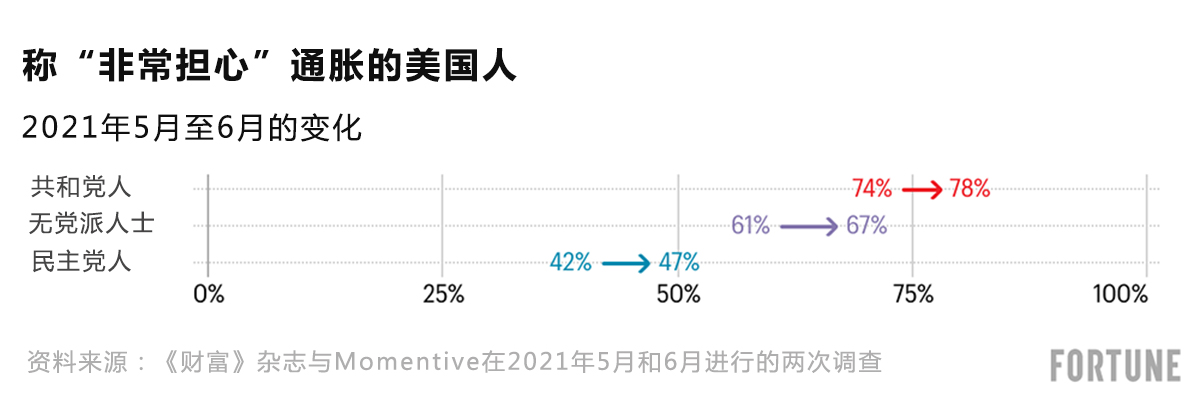今年6月的最新数据显示,5月的消费者价格指数(CPI)同比上涨了5%。这是自2008年以来通货膨胀率上涨最高的一次。
该数据公布后不久,美联储(Federal Reserve)的主席杰罗姆•鲍威尔就在美国国会重申,通胀上升是“暂时的”,一旦被压抑的需求释放完毕,价格增长将会冷却。然而,美国财政部的前部长拉里•萨默斯就不那么乐观了。萨默斯同意部分上涨是“暂时的”,然而,他也认为财政支出的大幅增加——例如3月的1.9万亿美元一揽子计划——有可能导致经济过热,从而带来更多的通胀。
不管是什么原因,通胀正在侵蚀美国人的家庭预算。为了解美国人对物价上涨的担忧程度,《财富》杂志与Momentive(原名SurveyMonkey)合作,于6月11日至14日期间对2000多名美国成年人做了调查。我们在4月30日至5月3日期间也做了一个类似的调查。
我们的结论是什么?人们对通胀的担忧在继续上升。在美国成年人中,87%的人表示担心通货膨胀,其中63%的人称“非常担心”。后面这个数字高于我们5月民调的57%。如果这种担忧继续上升,就可能转化为消费者行为的变化,甚至可能让一些消费者厌恶风险。

在5月7日《财富》杂志的《Analytics》时事通讯中,我们告诉读者,我们的数据表明,如果通胀加剧,就可能会演变成政治问题。后来,官方发布的通货膨胀率上升,随后更多的共和党人开始指责白宫。只要看看参议院少数党领袖米奇•麦康奈尔在上周的表现就知道了,他呼吁人们关注“肆虐的通胀”,并对民主党的支出方案加以抨击。共和党领导人抓住物价上涨这一点并不奇怪:调查显示,78%的共和党人对通货膨胀“非常担忧”,比例明显高于民主党人的47%。但更让白宫担心的是,67%的无党派人士也“非常担心”通货膨胀,高于5月的61%。
展望未来,经济学家们迫切希望看到6月的CPI数据,该数据在7月13日有所下降。他们希望通货膨胀率能够稍微缓和一些。(财富中文网)
*调查方法:该调查于6月11日至14日期间在全美2098名成年人中开展。模型误差估计是正负3个百分点。研究结果根据年龄、种族、性别、受教育程度和地理位置进行了加权。
译者:Agatha
今年6月的最新数据显示,5月的消费者价格指数(CPI)同比上涨了5%。这是自2008年以来通货膨胀率上涨最高的一次。
该数据公布后不久,美联储(Federal Reserve)的主席杰罗姆•鲍威尔就在美国国会重申,通胀上升是“暂时的”,一旦被压抑的需求释放完毕,价格增长将会冷却。然而,美国财政部的前部长拉里•萨默斯就不那么乐观了。萨默斯同意部分上涨是“暂时的”,然而,他也认为财政支出的大幅增加——例如3月的1.9万亿美元一揽子计划——有可能导致经济过热,从而带来更多的通胀。
不管是什么原因,通胀正在侵蚀美国人的家庭预算。为了解美国人对物价上涨的担忧程度,《财富》杂志与Momentive(原名SurveyMonkey)合作,于6月11日至14日期间对2000多名美国成年人做了调查。我们在4月30日至5月3日期间也做了一个类似的调查。
我们的结论是什么?人们对通胀的担忧在继续上升。在美国成年人中,87%的人表示担心通货膨胀,其中63%的人称“非常担心”。后面这个数字高于我们5月民调的57%。如果这种担忧继续上升,就可能转化为消费者行为的变化,甚至可能让一些消费者厌恶风险。
在5月7日《财富》杂志的《Analytics》时事通讯中,我们告诉读者,我们的数据表明,如果通胀加剧,就可能会演变成政治问题。后来,官方发布的通货膨胀率上升,随后更多的共和党人开始指责白宫。只要看看参议院少数党领袖米奇•麦康奈尔在上周的表现就知道了,他呼吁人们关注“肆虐的通胀”,并对民主党的支出方案加以抨击。共和党领导人抓住物价上涨这一点并不奇怪:调查显示,78%的共和党人对通货膨胀“非常担忧”,比例明显高于民主党人的47%。但更让白宫担心的是,67%的无党派人士也“非常担心”通货膨胀,高于5月的61%。
展望未来,经济学家们迫切希望看到6月的CPI数据,该数据在7月13日有所下降。他们希望通货膨胀率能够稍微缓和一些。(财富中文网)
*调查方法:该调查于6月11日至14日期间在全美2098名成年人中开展。模型误差估计是正负3个百分点。研究结果根据年龄、种族、性别、受教育程度和地理位置进行了加权。
译者:Agatha
At its last reading in June, the Consumer Price Index was up 5% year-over-year in May. That's the highest inflation uptick since 2008.
Soon after that data was published, Federal Reserve Chair Jerome Powell went in front of Congress and reaffirmed his belief that rising inflation is “transitory" and price growth will cool once pent-up demand runs its course. Former Treasury Secretary Larry Summers is less optimistic. Summers agrees some of the hike is “transitory," however, he also thinks the huge increase in fiscal spending—a $1.9 trillion package in March—runs the risk of overheating the economy and causing more hikes.
Regardless of why it is happening, it's eating into household budgets. To see how concerned Americans are about rising prices, Fortune teamed up with Momentive (formerly known as SurveyMonkey) to poll more than 2,000 U.S. adults between June 11 and 14. We did a similar poll between April 30 and May 3.
Our finding? Inflation fears continue to rise. Among U.S. adults, 87% say they're concerned about inflation—including 63% who say they're "very concerned" about inflation. That latter figure is up from 57% in our May poll. If these fears continue to rise, it could translate into shifting consumers behaviors—maybe even making some consumers risk averse.
In our Fortune Analytics issue on May 7 we told readers that our data suggested if inflation picked up, it could turn into a political issue. Since then, official inflation has risen, and subsequently more Republicans are blaming the White House. Look no further than Senate Minority Leader Mitch McConnell calling attention to "raging inflation" last week while also knocking Democratic spending. It's no surprise that GOP leaders are latching onto price hikes: When it comes to inflation, a significantly higher percentage of Republicans (78%) are "very concerned" about inflation compared to their Democratic peers (47%). But what's more concerning for the White House is that 67% of Independents—up from 61% in May—are "very concerned" about inflation.
Going forward, economists are eager to see the June CPI figure, which drops on July 13. They're hoping the rate of inflation subsides a bit.
*Methodology: The Fortune-Momentive poll was conducted among a national sample of 2,098 adults in the U.S. between June 11 and 14. This survey’s modeled error estimate is plus or minus 3 percentage points. The findings have been weighted for age, race, sex, education, and geography.






